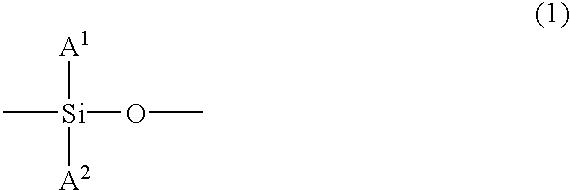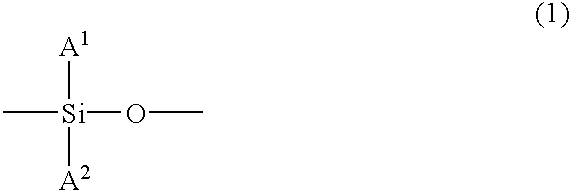Photoreceptor of electrophotographic system, process cartridge and image forming apparatus
a photoreceptor and electrophotographic technology, applied in the direction of electrographic process apparatus, instruments, corona discharge, etc., can solve the problems of reducing image quality, electrophotographic characteristics and durability are not necessarily satisfactory, and the photoelectric properties of the photoreceptor are impaired
- Summary
- Abstract
- Description
- Claims
- Application Information
AI Technical Summary
Problems solved by technology
Method used
Image
Examples
example 1
Production of a Photoreceptor of an Electrophotographic System
[0107] A coating solution for an undercoat layer made of 100 parts of a zirconium compound (trade name: Orgatics ZC540, made by Matsumoto chemical Industry Co., Ltd.), 10 parts of a silane compound (trade name: A1100, made by Nippon Unicar Co., Ltd.), 400 parts of isopropanol and 200 parts of butanol is prepared. This coating solution is dip-coated on a cylindrical Al substrate subjected to honing treatment, and heat-dried at 150.degree. C. for 10 minutes to form an undercoat layer having a thickness of 0.1 .mu.m.
[0108] Subsequently, 10 parts of chlorogallium phthalocyanine crystals having intense diffraction peaks at Bragg angles (2.theta..+-.0.2.degree.-) of 7.4.degree., 16.6.degree., 25.5.degree. and 28.3.degree. in an X-ray diffraction spectrum as a charge generation material is mixed with 10 parts of a polyvinyl butyral resin (trade name: S-LEC BM-S, made by Sekisui Chemical Co., Ltd.) and 1,000 parts of butyl acetat...
example 2
[0110] An undercoat layer and a charge generation layer are formed as in Example 1.
[0111] Subsequently, 20 parts of the benzidine compound represented by formula (34), 30 parts of a bisphenol (Z) polycarbonate resin (viscosity average molecular weight 4.4.times.10.sup.4), 150 parts of monochlorobenzene and 150 parts of tetrahydrofuran are mixed to form a coating solution. The coating solution is dip-coated on the charge generation layer, and heat-dried at 115.degree. C. for 1 hour to form a charge transport layer having a thickness of 20 .mu.m.
[0112] Further, molecular sieve 4A is added to 10 parts of a polysiloxane resin (containing 1% by weight of a silanol group) made of 80 mol % of a methylsiloxane unit and 20 mol % of a methylphenylsiloxane unit. The mixture is allowed to stand for 15 hours for dehydration. This resin is dissolved in 10 parts of toluene, and 5 parts of methyltrimethoxysilane, 5 parts of hexamethylcyclotrisiloxane and 0.2 part of dibutyltin acetate are added the...
example 3
[0113] A photoreceptor is produced as in Example 2 except that octamethylcyclotetrasiloxane is used instead of hexamethylcyclotrisiloxan-e.
PUM
| Property | Measurement | Unit |
|---|---|---|
| thickness | aaaaa | aaaaa |
| thickness | aaaaa | aaaaa |
| thickness | aaaaa | aaaaa |
Abstract
Description
Claims
Application Information
 Login to View More
Login to View More - R&D
- Intellectual Property
- Life Sciences
- Materials
- Tech Scout
- Unparalleled Data Quality
- Higher Quality Content
- 60% Fewer Hallucinations
Browse by: Latest US Patents, China's latest patents, Technical Efficacy Thesaurus, Application Domain, Technology Topic, Popular Technical Reports.
© 2025 PatSnap. All rights reserved.Legal|Privacy policy|Modern Slavery Act Transparency Statement|Sitemap|About US| Contact US: help@patsnap.com



